I said that twice this weekend. Saturday morning we started working on the new native garden in front of the house. A little after noon, as we were struggling to wrestle the fountain rock into position, I suddenly heard a distinctly loud buzzing sound. Then I realized the buzz was bees, thousands, and thousands of bees. Proof that swarm season is in full swing.
The question was, were they feral bees from the surrounding woodland, or our bees!? We’d heard bees above the chicken coop last summer, but never could find the source of the buzzing. I ran down to the farm road and looked up the hill toward the hives. Everything seemed calm and quiet at the entrances.
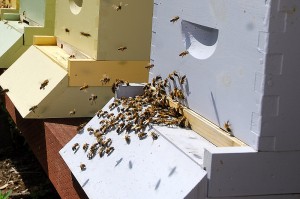
We were concerned the Lavender colony may have swarmed, even though we had recently split this colony
Then I realized that it sounded as if the swarm was following me overhead, travelling with me as I walked down the road.
Mr. Curbstone took the other road, up toward the orchard and apiary. From that vantage he could see the bees weren’t very clustered, but were up quite high. By the time I joined him this massive loose cloud of bees slowly rose up and over the redwoods along the creek, and then out of view. A truly amazing sight, and fortunately, not our bees.
Two weeks ago we mentioned we were anxious to split our Lavender colony, because there was a run of bad weather heading in toward the coast. We expected as soon as the warm weather returned, that colony may be ready to swarm. We wanted to split Lavender before she swarmed though, and hoped that by splitting that hive we would not only create a new colony of bees, but might even prevent the Lavender colony from swarming at all this spring.
Sunday afternoon, right after we’d fed the goats, and were standing outside the goat yard, I suddenly heard the roar of another swarm?! Really? It was unbelievably loud, much louder than the swarm the day before. I ran up to the road, and looked straight toward the apiary. I couldn’t believe what I saw.
Perhaps motivated either by the beautiful weather this weekend, or maybe the feral cloud of bees that buzzed by them the day before, at 1:10PM on Sunday, it was clear that this time Lavender was definitely swarming.
An enormous beard of bees was welling up across the face of the hive, and the air suddenly seemed to be seething with bees. It was an amazing sight…and sound! At first I couldn’t believe these were all Lavender’s bees. We were just in the hive two weeks ago, we’d split the colony by at least a third to half, and added plenty of empty combs to give the Queen lots of room for eggs. We still couldn’t believe that all these bees in the air fit inside that hive! I was truly awestruck.
Of course, I ran in the house to grab my camera, having no clue if I’d even be able to photograph them. When I returned, the area above the orchard road seemed to have the worst air-traffic control problem I’ve ever seen. There were bees EVERYWHERE. It looked like mass confusion all across the apiary airspace. Although there is an element of randomness in swarming, in regards to which bees leave with the swarm, and which bees stay in the original hive, there is clearly a lot of communication going on amidst all the pandemonium. It’s truly amazing to watch.
To get these photographs, I first had to walk THROUGH the swarm, which was only a few feet above the ground along the orchard path.
I had no hat, no veil, no bee suit, but forged ahead through the swirling cloud. Swarming bees, having just gorged themselves on honey (there goes the honey harvest), are generally very placid. I had one worker bee get a little in my face, but the bees were mostly too busy to worry about me. As I made it up the path to the level of the hives, the darker contrast of the trees behind the swarm made the bees even easier to see.

Although some bees were leaving with the swarm, others clearly were trying to get back inside the hive
The bees at this point were still quite well spaced apart in the air, and mostly hovering as a large loose cloud. We tried to see where they were heading, but they didn’t seem to be going in any particular direction at first.
The difference between Lavender’s swarm, and the swarm the day before, may have been timing. Generally bees will swarm, with the old Queen, and land somewhere near the original colony, perhaps in a tree, or on a fence. They’ll then cluster, to protect the Queen, and regulate body heat, while a few scout bees fly out to look for a new suitable home. Bees are typically homeless for a few days until new accommodations are secured. Swarms will typically stay clustered where they landed for 1-4 days, and once a suitable home has been found, the scouts communicate to the cluster that it’s time to move. Saturday’s swarm of feral bees that flew overhead looked like they had a purpose, and a direction. Perhaps they were finally moving to their new home.
Lavender though had only just swarmed, we were watching it happen. They were in the first phase of locating their Queen, and just starting to settle into a cluster. If you turn up the volume while watching this video, you should be able to hear the bees, although the video really doesn’t compare to standing outside with thousands of bees swirling all around you.
The video isn’t very long, because while I was filming this video Mr. Curbstone was suddenly stung (the bees really seem to like him this season), and at first it looked like he’d been stung inside his mouth, which, for a brief second, scared me. Needless to say, I set the camera down, and we dashed into the greenhouse, as he’d now been marked. I was relieved to see that he’d only been stung on the lip, as stings inside the mouth are especially dangerous, and a medical emergency, even for someone not allergic to bee stings.
After that momentary diversion, we noticed that the chaos outside the greenhouse was quickly starting to become more organized, and it was clear the bees were beginning to settle in an oak tree to the left of the hives. Unfortunately, way way WAY up in a Live Oak tree, about 30-35 feet over our heads.
There was no way we were going to be able to reach them that far up off the ground, especially with the slope.
All we could do was watch, and bid the Lavender Queen farewell. I admit it is disappointing to lose her, as she’s been a very good Queen, but after the losses this winter, it’s also heartening to see these bees are doing so well.
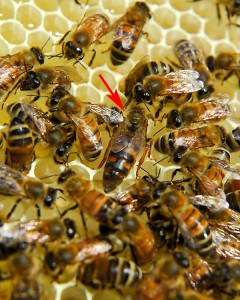
The Lavender Queen (red arrow) will have left with the swarm, and hopefully will be replaced by a new Queen
Now it’s entirely up to the bees where the Lavender Queen will next take up residence. We do have bait hives out, but the bees will choose where they want to live.
We’d love to have the Lavender Queen return to the apiary, but the bees may choose to bypass the bait hives entirely. We’ll have to wait and see. Remarkably this colony was captured as our afterswarm colony exactly one year ago today.
Our lesson here is that for these colonies that build up so well in late winter, we should split early, perhaps February, and often! We easily could have split Salvia, and Lavender, into at least three hives each.
My only fear now is that we moved the Queen cell we found during the split. If the Queen had stopped laying soon after the Queen cell was being constructed, in preparation for swarming, the remaining bees in the Lavender colony may not be able to make a new Queen.
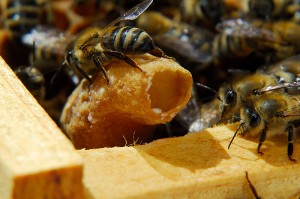
The bees were making a new Queen when we split the colony, and we're now concerned we've left them incapable of making a new Queen
Unless there are eggs, or another Queen cell, the remaining bees that didn’t leave in the swarm will be unable to produce a new Queen. We’re crossing our fingers that in the last two weeks they had already produced another Queen cell, or there was one we missed. We won’t know for certain until we recheck this hive. So we’ll have to recheck the remains of the colony soon. If necessary, we can combine the remains of the colony back with new Chamomile hive. Alternatively, if we find more Queen cells, we may have to split again to decrease the chance of an afterswarm! I can’t even guess at how many bees have buzzed through our apiary in the last 48 hours!
There’s nothing like beekeeping to keep you on your toes! Needless to say, we’ll update once we know more.

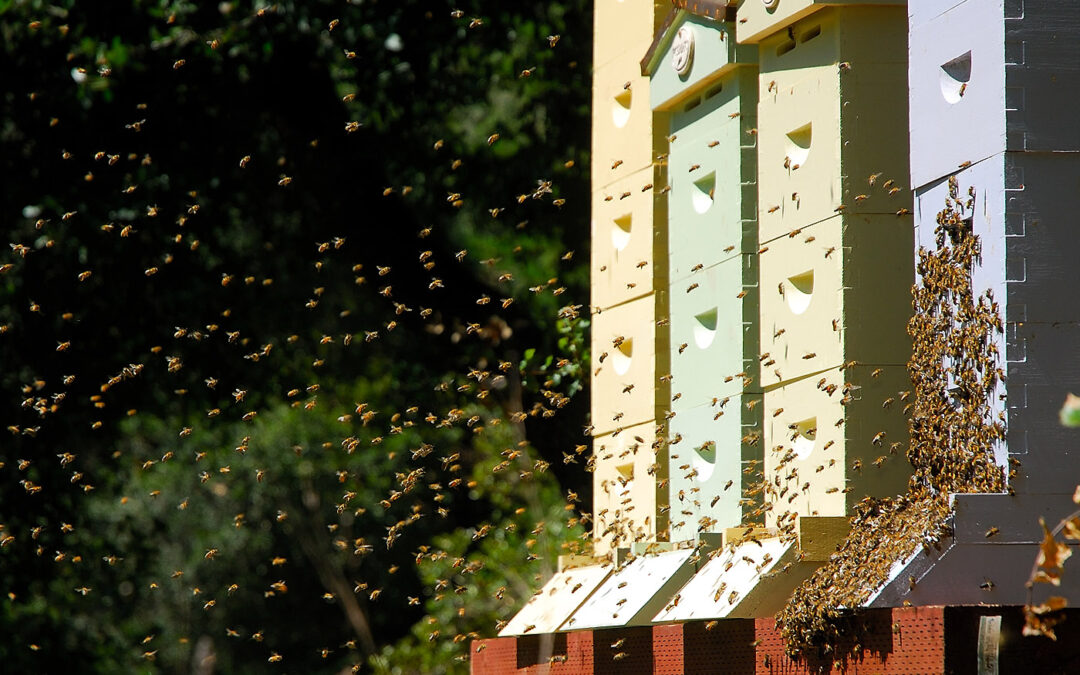
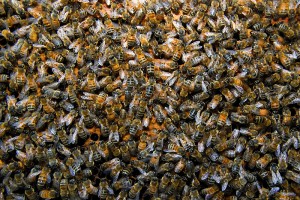
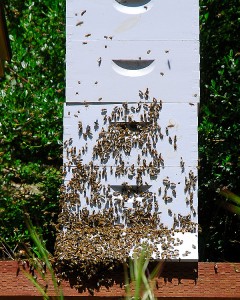
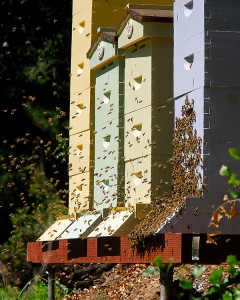
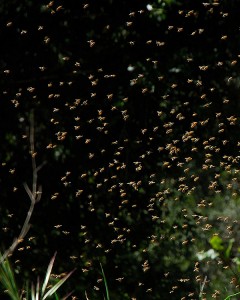











Clare,
Oh my! Hope you get another swarm to fill them back up! Just in from my new out yard, yes out yard. I caught a 4-5 pound swarm this morning and set up a hive at the farm down the road. No more room for bees here with 5 hives in our yard.
I suspect when we check on Lavender there are still a lot bees in this hive. Most of the bees bearding on the hive front seemed to be trying to get back in. What we weren’t sure of is whether the entire hive emptied out during the swarm at first, it sure looked like it.
This afternoon, I was outside when the Salvia hive swarmed too. They didn’t really beard, they just took off, albeit their swarm seemed smaller, but it took them much longer to settle in the oak tree, right next to the Lavender swarm. Clearly, they’re in a cahoots! 😯
So interesting! I love following your blog and the adventures at CVF Clare…
Haha, you should try following us in person. Honestly, I swear, some days it’s like the funny farm around here 😉
This was fascinating and so well documented. I loved it. You have the most wonderful, eventful life.
We had a big swarm in our chimney last week. We built a small fire of wet paper and wet twigs to smoke them out. I want lots of bees, but not down the chimney. We had dozens in the house and I used a little bug-vac to suck them up and release them outside.
I’ll stay tuned!
Sharon
It’s definitely eventful! I don’t blame you for not wanting bees in your chimney, not the most convenient place for them to take up residence! Glad you managed to vacuum the stragglers and send them on their way!
Our one hive swarmed a little over a week ago. I missed the exit, but found the cluster up in a tree. It’s hard to say exactly what I could have done to prevent it, though removing some brood frames and putting in bare foundation might have helped. I don’t want a second hive at this point, so a split was out of the question. We had such a mild winter, I’m guessing the queen didn’t slow down as much as usual, hence an early overcrowding and then a swarm. I did an inspection a week later, and I could hardly tell any bees were missing! I did find a finished queen cell, So there should be a new queen shortly, if not already.
All things considered, I’d rather have a healthy, prosperous hive swarm, than have a sickly, struggling one die off, you know?
That’s definitely a problem. We’re even trying to figure out how many more hives we can sensibly have here, and honestly, I think 6 would be our limit. The only thing to do if you want to split, is to make nucs and sell them. I agree, I’d rather have strong bees, than sickly ones. I want bees that don’t need the entire medicine cabinet poured into the hive to get them through.
As Salvia took off today as well, I suspect we’ll open her hive and it won’t look like any bees left. That Queen was a bee-making machine! I can only hope that the replacement Queens for Salvia and Lavender will be at least half as robust. It’s not that I don’t want young healthy Queens, you just never quite know what you’ll get with a new unproven Queen. I can’t believe that we now have no Queens in our apiary that were in residence last spring! Somedays I’m sure my life should run to keystone cop music in the background 😛
Wow, that is impressive! I can imagine how loud it is in person. I hope they find a good home preferably your bait hives. Glad to hear your hubby is doing well after his second sting of the season.
Fortunately Mr. CV’s face was much closer to normal proportion this morning. I don’t envy him though, especially when that sting starts to itch in a day or two! 😉
You are a braver person than me! I can’t imagine walking through all those bees! I am glad Mr. Curbstone was not seriously injured. Listening to the video I could imagine all sorts of frightening things. It is always so interesting to follow the adventures of Curbstone Valley. I look forward to finding out what happens with the swarm and also the remaining Lavender bees.
There are definitely occasions I wouldn’t have done that, like if a hive had been knocked over. The swarm situation tends to be ‘relaxed’ though. I knew they’d recently gorged on honey, and that their priority would be tracking the Queen, not me. Of course, Mr. CV proved you can get stung even during a swarm, but I think we both had much more grief from the bees the last time we inspected the Lavender hive. Clearly we need to do an apiary-wide inspection this week. Two split hives with unknown Queen status, and two hives that swarmed this week! It looks a lot like spring around here at the moment!
Unbelievable that they swarmed after you divided them and that they swarmed a year later…what an amazing sight and sound.
Swarming a year to the day did seem rather bizarre, but when Salvia took off today, a day later, I think I was even more surprised. Salvia proved that even splitting early is no guarantee as that hive was split in February, and yet both hives took off a day apart. I’m sure our warm weather this winter enabled the bees to bulk up excessively this spring. I predict this will be a banner swarm year all around, as it seems many beekeepers had a good year this last year overwintering their bees, which leaves many more colonies to swarm this spring. Those swarm catchers out there will be hot-footin’ it all season I expect!
Bravo! Great storytelling. I know nothing about honey bees, but was completely caught up in the drama. I sure hope a new queen is getting ready to emerge and I’m glad your husband’s bee sting wasn’t serious.
I really hope Lavender has a Queen cell ready to pop. I did a little more reading and generally a healthy Queen doesn’t seem to stop laying altogether before swarming. She’ll cut back heavily on egg laying, but won’t stop, so even if there’s no Queen cell, if there are eggs, they can still produce a new Queen. I’m going to cross my fingers, and hope the bees know exactly what they’re doing. We apparently don’t, as we’ve lost two Queens in two days 😛
Seems like there’s always some excitement happening when beekeeping! I would have been too afraid to go out in that swarm! And so sorry you husband got stung – again!!! Does that make him a little wary of bees? It would me! I hope the Lavender queen will do well, wherever she decides to make her home. And I hope you have a new queen in the making!
It’s funny, understanding more about bee behavior now, a swarm is one thing I’m much less fearful of. I’m more nervous going up to feed a colony than I was walking through the swarm yesterday.
Mr. CV is much braver than me. For reasons I won’t bore you with, I’m supposed to avoid getting stung, so I’m the overly cautious one. Mr. CV though is routinely doing inspections without gloves etc., so because he takes more risks, he occasionally gets a few extra stings 😉 Bee kisses though wasn’t quite what he expected!
That was fascinating! I’ve never seen a swarm before. I don’t think I would’ve been as brave as you. Glad Mr. C wasn’t stung in the mouth and is okay.
I’ve never seen bees in the act of swarming. I’ve seen swarms, but by the time I’ve seen them in the past they’ve already settled in a tree or a shrub. It really was remarkable just how much air space a swarm can occupy before they settle. I didn’t expect I’d see that twice in two days though!
I really was momentarily terrified Mr. CV had been stung in the throat when he didn’t answer me. I was ready to dash in the house for the antihistamine and the Epi-Pen, so I was very relieved that all he got was a fat lip! Can’t blame the bee though, there was a lot of activity in the apiary at that moment.
It is amazing to see bees swarm. Not quite warm enough for that in Ireland though…yet.
It probably won’t be long. We didn’t see any swarms here until this last week, and we’ve seen almost half a dozen this week (only two from our apiary though).
I’m hoping we’ve been able to keep our hive from swarming, though with NW Carniolans they have a habit of swarming easily because they can build up numbers so fast. We did do a split and gave them a bunch of new frames so I’m hoping that helped. We went in 2 weeks ago to check on them. There were a couple of insurance queen cups but no queen cells. We need to check on them again this weekend. It’s a good thing we have an extra hive ready to go if we have to use it.
Our ferals have the same issue. They produce more bees than honey, so population overrun happens fast. Salvia’s source colony swarmed multiple times last year. Judging by the numbers of Queen cups we found in this hive, and in Salvia this weekend, both colonies were seriously considering swarming again. We had to buy more equipment this weekend to split into. We probably could have split more, but at some point we have decide just how many colonies we want to manage.
What a great tale, and your bravely won images bring it to life. I would like to have heard the bees as they decided who would go and who would stay (“But Bertrand I will miss you so!”) I’ve heard swarms in the air, loud and powerful sounding. Once a swarm settled on our front porch column for a bit, looking like it grew there. Another time Mr O removed one from our house wall (took off the siding, a big project) and he moved the bees into a wooden hive. But we were raising children and distracted and the hive didn’t survive the second winter. I would like to try again with bees sometime. I very much enjoyed this post!
When Lavender swarmed, it looked like the entire contents of the hive emptied out, and then some went back in. With Salvia, it just looked like a large orientation flight at first, we didn’t see the same magnitude of bearding. It was interesting seeing the differences in the hives over the weekend, in regards to what’s left in each colony. I’ll try and post about that early next week.
Clare, I haven’t been keeping up with my blog reading lately and I’ve missed so much! Two hives swarming and a new native plant garden with fountain. You’ve been very busy lately. Glad to hear that despite losing some bees, your hives are doing so well and are so healthy. After losing the other hives you must feel good knowing these ones are very robust.
It is unfortunate that swarm season coincides with our busiest time of year. April always seems to be a month jam packed with things we need to get done. I have been very impressed with these bees thus far. Unfortunately, at this point, every hive is one badly mated Queen away from disaster. We’ll have to keep an eye on all the colonies now to see if they produce new successful Queens. The suspense continues…
Clare, I love to learn from your bee encounters and lessons. My hive seems a little subdued lately, which worries me, but all things seem okay when examined. I failed to move supers earlier so now the bees have moved up two levels and are exiting from right below the queen excluded super. Time to fix that. This is my year of getting honey, hopefully. I still say you have the best looking hives on the West Coast. Good Luck!
Last we checked the hives, the bees were downright cranky. This weekend though, post swarm, all of our hives were very calm and subdued. If I hadn’t seen them swarm, I would have been very concerned at the lack of brood, and the relatively higher population of drones. What really struck me though was how completely placid the colonies are right now. As for honey, for us, we waited too long, and should have harvested pre-swarm. As the bees gorge before taking flight, they took most of the harvest with them!
Wow, that was fascinating stuff. The life of bees is indeed quite extraordinary and how fortunate you are to be able to look on amazing events like swarming. Great post.
They really do live extraordinary lives. After this first full year of beekeeping, from swarm season, to swarm season, I really do see why some find it easier to think of a colony of bees as a whole organism. If only humans worked that well together! 😉
Wow, that’s a lot of bees! It is so fascinating, as I don’t know a lot about bee hives. I hope a new Queen emerges!
It seems we’re now waiting for Queens in SEVEN colonies! The problem with successful bees, is you can quickly double the size of your apiary, without hardly trying! 😛
wow. cool. but it makes me nervous from several thousand miles away.
It’s really not too much to be nervous about. Swarms can get a bit irritable occasionally, but generally they just want to go about their business, and aren’t much of a bother, unless of course they cluster on your car!
I nominated your blog for The Versatile Blogger award. Here’s some information: http://versatilebloggeraward.wordpress.com/vba-rules/
Thank you Mary! We’re very honored 🙂
Wow you sure were brave to go up amongst them Clare – the adrenalin must have been flowing. I really hope those bait hives work for you.
Actually, I wasn’t nervous at all…well, not until Mr. CV got stung 😉 I might have been a little cavalier, but I think more than anything else, I was in awe. The bait hives now are full, as we had to split both swarm hives out, and needed every single piece of equipment we could muster! 😛